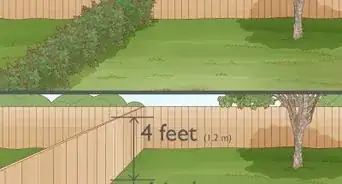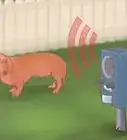This article was co-authored by Ty Villacreses. Ty Villacreses is a Dog Behavior & Training Expert, as well as the Owner of Bow Wow Behavioral, LLC in the Chicago area. With five years of experience, he specializes in positive reinforcement obedience training and deference training for puppies and adult dogs. Additionally, Bow Wow Behavioral LLC has a 5-star rating.
This article has been viewed 23,184 times.
The Monks of New Skete are widely respected for their work with German Shepherd dogs. This article will summarize their advice, but to apply their principles it's best to read the book.
Steps
-
1See your dog as a reflection of yourself. This is not required, but it does shed light on how the monks view and treat their dogs.
- "On a deeper level, when we pay close attention, dogs mirror us back to ourselves in unmistakable ways that, if we are open, foster understanding and change."
- "You can't become a better trainer without becoming a better human being."
-
2Create a genuinely positive, encouraging attitude whenever you work with your dog. Dogs are very perceptive and will pick up on your negative emotions. Before training your dog, take a few deep breaths and clear your mind. Visualize the training session you're about to have with your dog. When you feel calm and ready, proceed.Advertisement
-
3Include your dog in your life on as many different levels as possible. The more you can do to bond and spend time with your dog, the better. This is also a great way to incorporate training into your daily routine so that your dog has an easier time adjusting.
-
4Use eye contact to communicate. Use gentle looks to foster acceptance and trust. Use piercing and sustained eye contact when your dog has done something it should not do, and knows it should not do (such as snapping at strangers).
-
5Approach training holistically. It's not just a set of exercises contained within sessions, though that is important.
-
6Understand your dog's roots. Learn about wolf behavior. Investigate the breed of your dog, and what that breed was intended to do.
-
7Use praise as a foundation, not just as a reward. Many people use praise to "bribe" their dog, and that's something a dog can easily see through. Praise your dog generously and genuinely. Find out what kind of praise animates your dog; experiment! Use both physical and verbal praise. Positive rewards are the best way to build positive behavior.
- "Praise is an attitude, a stance. Dogs who live in an atmosphere of praise come to love the human voice. They are more trusting and accepting. They are approachable by strangers but not demanding. Dogs confident of praise from their owners do not live o the edge of an emotional abyss, always seeking out attention and sulking when they do not get it. If praise is part of your attitude toward your dog, you have a rich and exciting relationship ahead."
-
8Use discipline with meaning and care.
- Never call a dog to you to discipline him. Always go to the dog, even if it means you have to chase him.
- Don't use objects to discipline or punish.
- Don't use your dog's name when correcting behavior.
- Discipline in proportion to the offense. Verbal discipline and leash corrections can fix most offenses.
- Make eye contact as you discipline.
- Be dramatic.
- Stop paying attention to the dog for about 30 minutes after a stern correction. Just be passive and avoid eye contact, you do not need to be aggressive or vocal at all. Then make up with your dog by taking him for a walk or giving him his favorite toy. It doesn't have to be dramatic, just resume your normal relationship.
- "Watch yourself - owners who are physically or verbally domineering wind up with cringing, neurotic dogs. Discipline, like praise, must be meaningful. It must communicate the owner's displeasure clearly, and on the dog's level of understanding and perception, for unacceptable behavior."
-
9Keep your dog healthy.
Community Q&A
-
QuestionHow do I introduce a new puppy to the senior home dog?
 Community AnswerMake sure to have both on a leash. Have two people doing it, with each person having one dog. Then watch them carefully. But DO NOT always pull back each time they get near each other or sniff each other. It will make them think there is something to be fearful of or tense about. They can feel if you are tense or very alert. Let them sniff each other's rear ends. This is how they sniff out the "dominance".
Community AnswerMake sure to have both on a leash. Have two people doing it, with each person having one dog. Then watch them carefully. But DO NOT always pull back each time they get near each other or sniff each other. It will make them think there is something to be fearful of or tense about. They can feel if you are tense or very alert. Let them sniff each other's rear ends. This is how they sniff out the "dominance". -
QuestionWho exactly are the Monks of New Skete?
 Community AnswerThe Monks of New Skete are actual monks that have developed a dog training method. The method helps to stop a dog's nuisance behavior and promotes a strong bond between dog and owner.
Community AnswerThe Monks of New Skete are actual monks that have developed a dog training method. The method helps to stop a dog's nuisance behavior and promotes a strong bond between dog and owner. -
QuestionWhat kind of treats or bones do I give the pups and dogs?
 Wolvy123Community AnswerOn packets it should say ages, for example 6 months plus. Find the right packet for your dog's age and reward your pups and dogs with treats for good behavior.
Wolvy123Community AnswerOn packets it should say ages, for example 6 months plus. Find the right packet for your dog's age and reward your pups and dogs with treats for good behavior.
Expert Interview

Thanks for reading our article! If you'd like to learn more about becoming a dog's best friend, check out our in-depth interview with Ty Villacreses.
References
- How to Be Your Dog's Best Friend (updated and revised edition) by the Monks of New Skete. The information in this article is drawn from this book.
-Step-1.webp)
-Step-2.webp)
-Step-3.webp)
-Step-4.webp)
-Step-5.webp)
-Step-6.webp)
-Step-7.webp)
-Step-8.webp)
-Step-9.webp)



























































